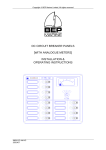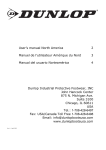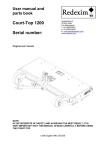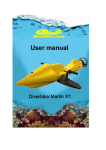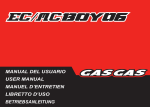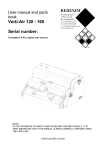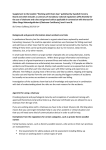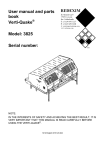Download CE-20 WATER BLASTER 500 Bar USER GUIDE & SPARE-PART
Transcript
CE-20 WATER BLASTER 500 Bar 3X 400 V 50 Hz 3X 440 V 60 Hz UNLOADER USER GUIDE & SPARE-PART BOOK 1 Thank you for choosing our water blaster. For your safety and correct operation, please carefully read the information and instructions in this manual before use. NOTE: All of the information stated in this manual is based on data available at the time of printing. DEN-JET reserves the right to modify or change its products and / or specification data at any time without prior notice. DEN-JET has no responsibility or liability regarding misuse of the product or use of the product with third party products. DEN-JET warranty’s is limited to repair or replacement of faulty items at the time of manufacture. DEN-JET has the copyright for this material and all kinds of reproduction are prohibited without DEN-JET’s permission. March 2008 Model: CE20-500 Technical details: 50 Hz Version W.P. Bar / Psi Flow Lpm / Gpm 60 Hz Version W.P. Bar/ Psi Flow Lpm / Gpm Electrical Spec. Motor Hp/ Kw Voltage 50/60 Hz Amperage A Dimensions L x W x H mm Weight Kg 2 500 / 7250 16 / 4.2 500 / 7250 16 / 4.2 20 / 15 400 / 440 21 / 19 1060 x 760 x 850 280 Index: General information Specification data .......................................................... 2 Index.............................................................................. 3 Certificate(s) of conformity .......................................... 4 Safety precautions ......................................................... 5-6 Medical emergency information ................................... 7 Set-up & Use Preparing for use, Operation of the machine ................ 8 Safety devices ............................................................... 9 Set-up & Use ................................................................. 9 Check ............................................................................ 9 Maintenance Lubrication .................................................................. 10 Cleaning ...................................................................... 10 Storage ........................................................................ 10 Trouble shooting / Repair Problem / Repair ......................................................... 11-12 Spare-part lists Main spare-part assembly ........................................... 13-14 Water Tank Spare-part assembly ................................ 15-16 Pump CE20-500 Spare-part assembly ....................... 17-20 Electrical System Spare-part assembly ....................... 21-22 Wiring diagram ........................................................... 23 Trigger Gun………………………………………….24-25 Operation Rotating Nozzle…………………………………....... 26 Replacement procedure Rep. Kit Rotating Nozzle………………………… .... 27 Sand Blasting Equipment ............................................ 28-29 3 Certificate of E.U conformity: DEN-JET Nordic A/S Terndrupvej 7, Astrup DK-9510 Arden Denmark According to E.U. Machine regulation 98/37/E.U. Appendix IIA We hereby declare that the electrical driven high-pressure water blaster machines: CE-20-350 50/60 Hz and CE-20-500 50/60 Hz Has been designed, manufactured and tested to fully comply with the health and safety requirements of the E.U. machine regulations. ANY modification or change of the machine without our prior consent will render this declaration null and void. Appropriate E.U. regulations: Coordinated standards Used particularly: Date: 12. May 2005 E.U. Machine Regulation (98/37/EU) Current issue. E.U. Low Tension Regulation (73/23/E.E.C.) E.U. EMC Regulation (89/336/E.E.C.) EN 809 EN 292 part 1 & 2 EN 574 Benny S. Jensen Managing Director. 4 pr EN 1889 EN 60204-1 EN 294 EN 50081-2 EN 6100-6-2 Safety Precautions: To safeguard the operator who uses the machine and its accessories and as accident prevention and protection of bystanders and property, the following safety precautions must be observed. Always treat the water blaster in the same way as any other power driven high speed cutting tool! Never let children or people who have not been properly instructed operate the machine. Use the electric plug in a proper socket with ground to earth wiring. The entire electrical installation must be with earth wiring! All electrical installations must be made only by an electrician. A GFCI (Residual current device) is recommended. Always keep the high-pressure cleaner and the belonging accessories in good working condition. Check that the machine and its accessories are free from defects, and in good working condition, with special attention to the insulation on the electric cable. In case of defect: Do NOT OPERATE THE MACHINE! Get the machine serviced. Eye protection must be worn at all times when operating the machine to protect against repelling or ricocheting materials hitting the eyes and causing damage. Ear protection must be worn at all times when operating the machine to protect against hear loss during operation. Proper footwear and protective clothing must be worn at all times when using the equipment to avoid and prevent damage to the operator. NEVER direct the jet at yourself. Do not attempt to clean your clothes or footwear with the machine. Precautions must be made to keep bystanders away from the working range. NEVER spray-jet on humans or live animals, the high pressure jet can cause severe injury. NEVER spray at electrical equipment, or at the machine itself. Make sure the machine is turned off and disconnected from the main power supply before service or repair. 5 Safety Precautions: The below shown protective clothing and devices should be worn both by personnel operating the water blaster system and equipment and by those working nearby: Operators must wear visors or goggles to guard against spray and flying debris. A combination of both goggles and visor is recommended. It will protect the eyes and the face during both water-blasting as well as abrasive water-blasting. Safety helmets must be worn at all time by personnel within the work area. Helmet material must be able to withstand mechanical shock exceeding 10G in 8ms without fracturing. Shear proof gloves must be worn by the operator at all times. A glove combination of a cloth inner lining and a water tight outer layer is preferable. Safety boots with steel toecaps minimum 0.5mm (0.02”) thick must be worn. The toecap must cover at least 30% of the footwear length. Basic safety footwear must also be equipped with metatarsal guards to protect the instep. Safety boots are available in numerous designs. Operators and other personnel exposed to noise levels of more than 90-dBa for more than 1 hour must wear suitable ear protection. Ear plugs or ear muffs are usually sufficient. Waterproof clothes protect the operator only from spray and flying debris. They do NOT deflect direct jet impact. Therefore, an operator must take care never to point a waterjet either at them selves or other personnel. 6 Medical emergency information: Immediate medical attention should be given to personnel who sustain equipment related injuries while operating the system. In such cases, it is vital that medical personnel be apprised of all facts relevant to such injuries. Therefore, all operating personnel should be provided with waterproof emergency medical alert tags or cards, describing the nature of their work and the possibility of injury inherent in the use of water jetting equipment. The below example of a standard card can be printed out or photo copied, bend, laminated and used as medical alert tag. 7 Preparing the machine for operation: 1) Place the machine in a safe location and secure the unit with lashing belts. 2) Freshwater Connection. Prepare the water supply for the blaster, by attaching a 3/4” hose to the supplied low pressure inlet coupling on the side of the water tank. Connect the other end to the fresh water supply from the vessel. Open for the water supply and fill up the water tank before starting the machine. Always use the inlet connection on the tank for supplying water. 3) High Pressure Hose Connection Mount the ½” high pressure hose to the blaster by attaching the swivel of the hose to the outlet fitting of the pump head. Please use 2 x 27mm spanners / wrenches to tighten the connection. Additional high pressure hoses supplied with the machine should be mounted now by using the supplied ½” nipples male-male to connect the hoses together. Please use 2 x 27mm spanners / wrenches to tighten the connection. 4) Trigger Gun Connection Mount the trigger gun with lance to the high pressure hose. Please use 2 x 27mm spanners / wrenches to tighten the connection. Mount the correct nozzle at the end of the lance. 5) Electrical Power Connection Connect the power cable CEE plug to an earthed 3 phase 32 Amp power socket. Should the CEE plug provided with the machine not fit your electrical system, replace the plug with one that fits. 6) Machine is now ready for operation. Operation of the Machine : A) Ensure that the water supply is open. B) Turn the main power switch to ON. Press the green START button – machine starts. Allow the machine a few seconds for the automatic star – delta switch to turn over. C) Get a firm grip with both hands on the trigger gun handle and lance handle. Press the trigger and start blasting. Always be aware of other crew members in your working area – Safety is first priority. Note: Do NOT let the machine run idle for more than 10 minutes, as it may cause damage to the pump. (water heats up). Shut-down of the Machine : A) Press the red STOP button – machine stops. B) Squeeze the trigger gun to release the pressure inside the high pressure hose. C) Turn off the water supply. Storage of machine during Winter time. Store the machine in a frost free location. Drain the water from the machine and flush the pump with anti-freeze fluid. 8 The machine is equipped with the following safety devices: a) STOP button. The STOP button (pos. 18 Electrical spare-parts assembly) stops the machine when pushed in. (The optional emergency STOP pos. 41 do the same, twist to release) b) Main switch. The main switch (pos. 19 Electrical spare-parts assembly) disconnects the main supply. UN-PLUG MACHINE WHEN REPAIRING!!! c) Over load relay. The overload relay protects the motor against overloading (pos. 27 Electrical spare-parts assembly) d) Safety valve. The safety valve built onto the top of the pump is protecting against overpressure (pos. 1 -500 Bar Pump assembly.) Set-Up & Use: Check Daily Inspection Task Check the strainer in the water-tank. Clean if necessary. Check the oil level on the crankcase of the pump. Fill up if necessary. Check for air-bubbles in the suction hose between tank and pump. If there are bubbles then tighten the hose-clips. Check high pressure connections for leakage. NEVER tighten connections under pressure. Check high pressure hoses for wear and cracks. Replace if necessary. Check the power cord for wear and cracks. Replace if necessary. Check the air intake grill of the electric motor. Clean for dust if necessary. Notice: To prevent damage to hoses and electrical cord, avoid letting the high-pressure hoses rub against sharp edges for example manholes or getting squeezed in door openings etc. Replace if necessary. Inlet water temperature must be below 60°C (140°F) 9 Maintenance: Maintenance Lubrication Task Oil renewal on the pump crankcase is to be completed the first time after no more than 50 hours of use. Oil renewal is hereafter to be completed in every 400 hours of use. Or at least one time a year. Use AGIP SAE 30 Oil or 15W40 Multigrade Oil. Quantity: 1,04 Liter (0,27 US Gallon) Fill up until the oil level is visible in the sight glass. Renewal of oil Switch off the machine. Loosen the oil drain screw on the lower back of the pump crank-case. Let the oil drain out into a waste oil-tray. Remount the oil drain screw and pour in new oil through the oil inlet on top of the pump until visible in the oil sight glass. Notice: Always dispose of the used oil in a proper manner. Cleaning A part of keeping the machine and its accessories in good working condition is keeping it clean. But NEVER clean the machine itself with high-pressure. Do not use solvents. Storage Keep the unit frost free, or flush the pump thoroughly with non alcoholic antifreeze fluid. 10 Trouble shooting and repair: Problem When the main switch is turned on And the green start button is pushed in, the Water-blaster will not start. Repair Fault somewhere in the power supply. The motor is humming but the pump does not run. Too low voltage, one phase is missing. High-pressure pump is blocked. Is the Power light on? Make sure the main supply cable is connected correctly. Inspect cord for cracks and wears. Check the mains voltage. Check the main connection oltage with a meter. With the machine turned off, hand turn the motor, at the fan, if it remains blocked, check the pump. The pressure drops and the Waterblaster works irregularly. The strain filter in the water tank is blocked or dirty or the water supply from the tap is insufficient. Air in the Suction hose. The Water-blaster is running at high pressure when trigger is released. The check valve in the un-loader out-let fitting is stuck or leaking. The Water-blaster does not reach the right working pressure when the trigger handle is activated. Leakage from: Safety valve, hose connections, trigger-gun. The pump sucks air. The high-pressure nozzle is worn or too big in size. The un-loader valve or safety valve is not correctly adjusted, or is worn. Plunger packings are worn. The Water-blaster works with approximately 2/3 of the maximum pressure, and the high-pressure hose is vibrating. There are dirt in the valves. Clean the strain water filter. The machine should always suck from the water-tank. Open fresh water tap fully. Tighten the hose clamps on the suction hose. Clean the check-valve in the un-loader out-let fitting. Replace the O-ring Turn of the water-blaster. Inspect for leakage. Replace the nozzle. Set the un-loader, repair if necessary. Change packings. Turn off the Water-blaster. Dismantle the pump head and the valves, remove the dirt and check to ensure the valve discs are moving freely and fits tight and smooth to their seats. 11 Trouble shooting and repair: Problem Excessive water leakage from under the pump Repair Packing is worn Noisiness The pump sucks air. One or more valve springs are broken or stuck. Dirt in the valves. No or too little oil in the crankcase or motor bearings worn out. Replace packing. (Always replace O-ring as-well) Inspect the low-pressure water supply. Tighten hose clips. Replace springs. Clean the valves. Replace the bearings. Water in the oil The Oil-seal is worn out. High moisture in the air (condensing inside the crankcase) The high pressure seals are completely worn out. Check or replace the oil-seals. Renewal of the crankcase oil more often. Replace the high pressure seals. Coupling Mounting 12












![ac circuit breaker panels [without meters] installation - thornam-shop](http://vs1.manualzilla.com/store/data/006886941_1-35cc363a8b64d2c248bc8206f0066550-150x150.png)
